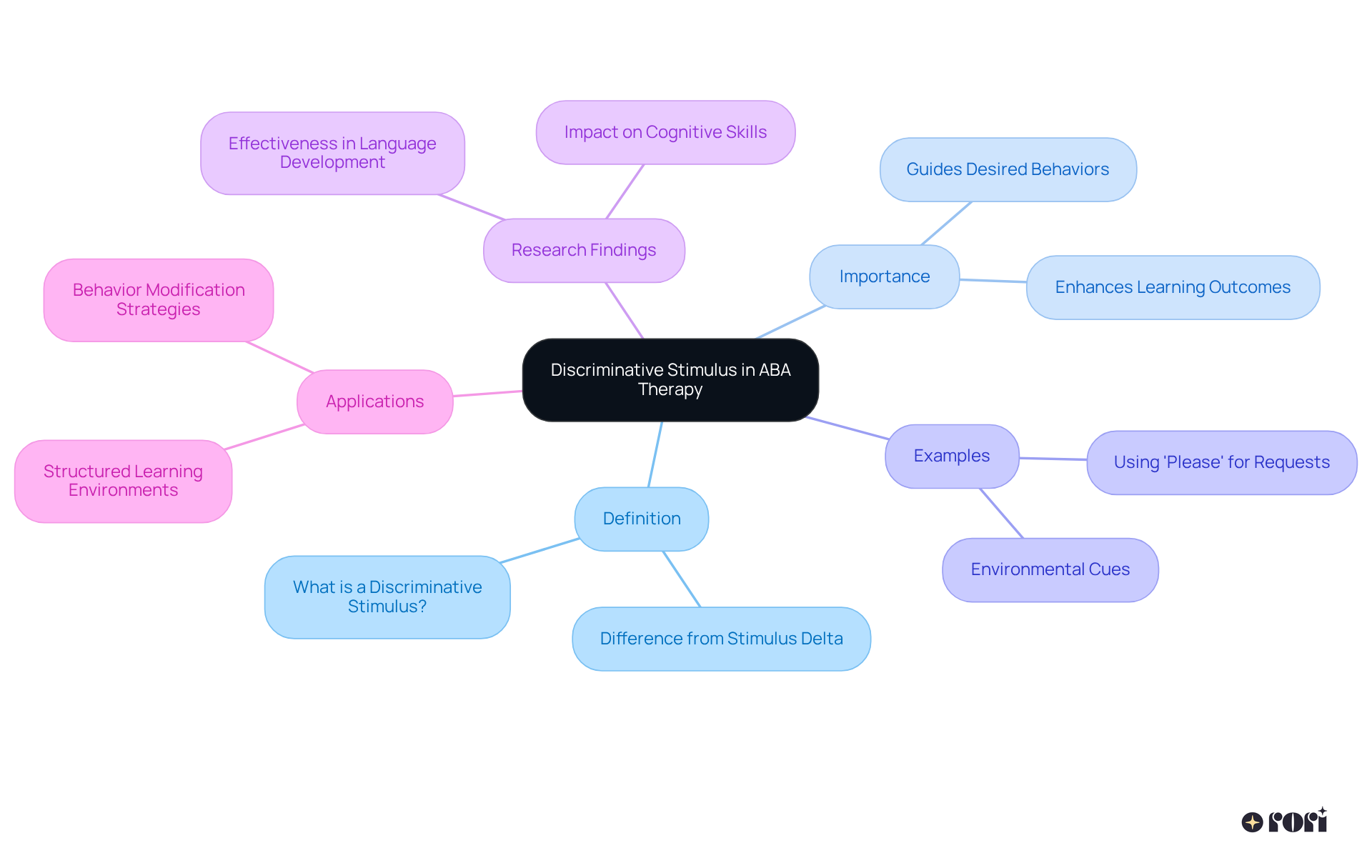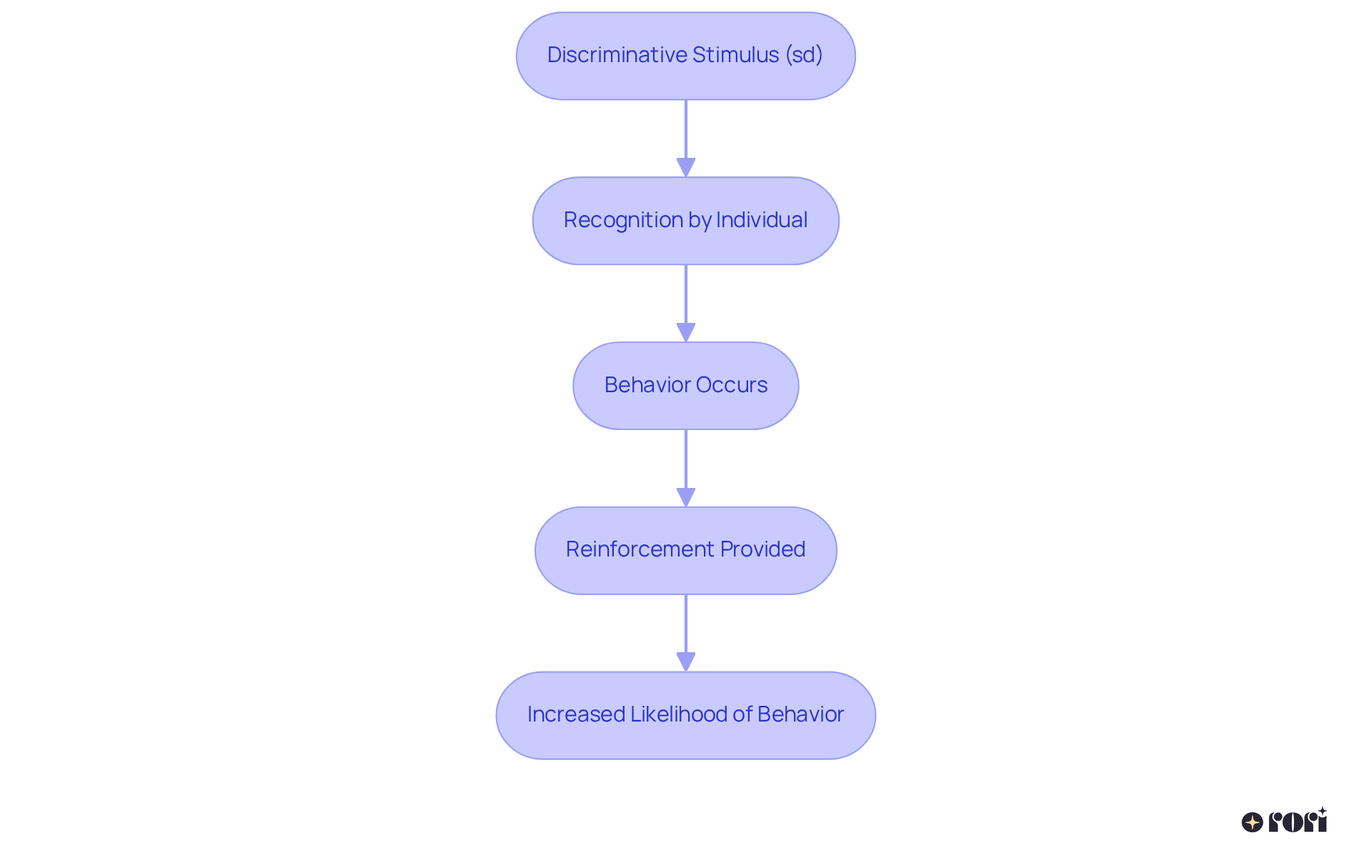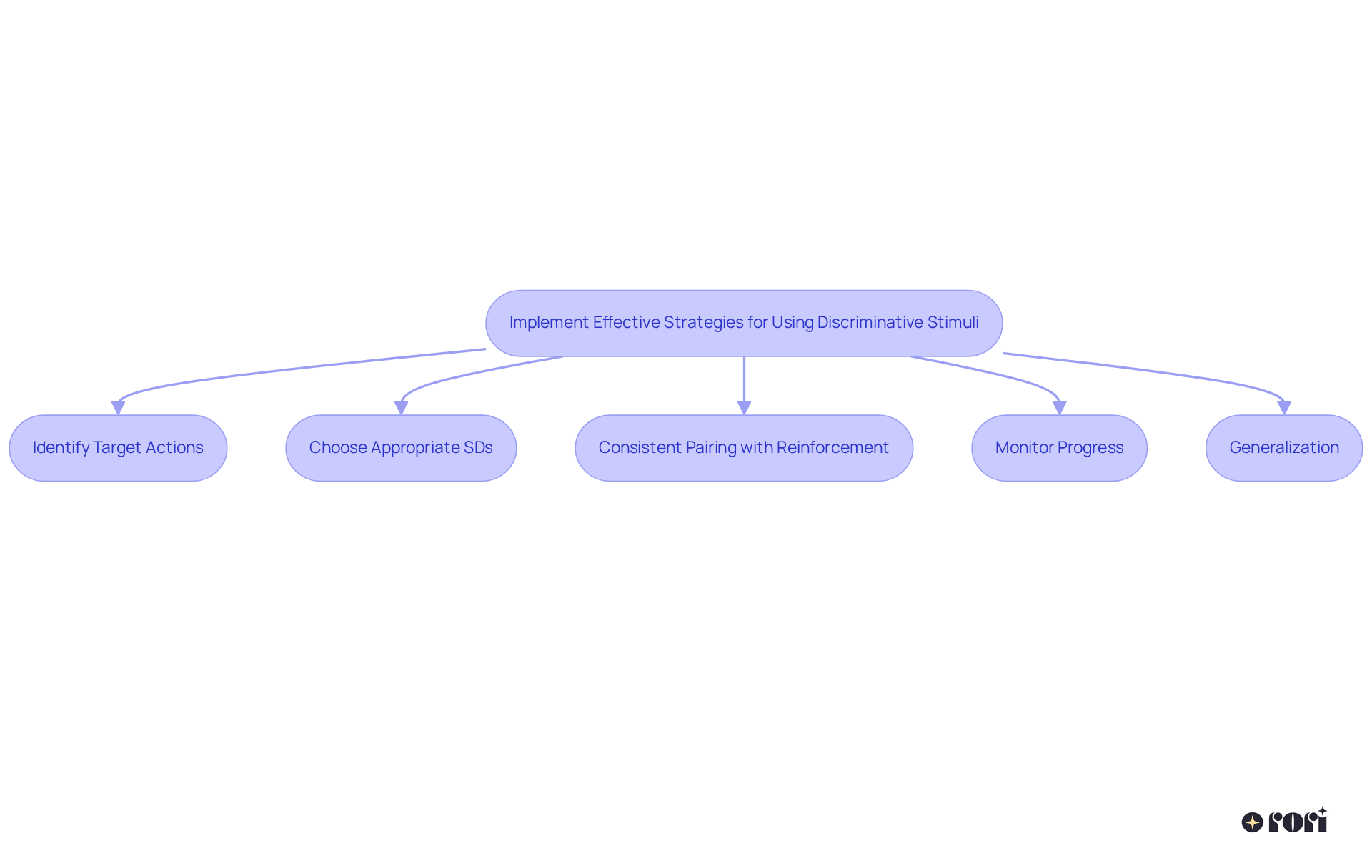This article dives into the world of discriminative stimuli (SD) in ABA therapy, which are like helpful environmental cues that tell us when certain actions can lead to rewards. It’s all about choosing the right SDs and pairing them with positive reinforcement to boost learning and behavior change in children with autism. Research backs this up, showing that structured use of these stimuli can really make a difference!
As parents, it’s important to understand how these cues work. Imagine a child responding positively when they see a favorite toy, knowing that playing with it might lead to a fun reward. It’s these little moments that can spark significant progress! By selecting appropriate SDs, we can create a supportive environment that encourages growth.
Let’s explore this together! By focusing on the right cues and reinforcing them positively, we can enhance our children’s learning experiences. Remember, you’re not alone in this journey—we’re here to help you every step of the way! If you have any thoughts or experiences to share, we’d love to hear from you!
Understanding the intricacies of behavior modification is essential in Applied Behavior Analysis (ABA) therapy, especially when it comes to the discriminative stimulus (SD). This unique environmental cue is like a friendly nudge, signaling the potential for reinforcement and shaping the learning experiences of children with autism. By diving into how SDs work, caregivers and therapists can discover powerful strategies that promote positive behaviors and enhance communication skills.
But let’s pause for a moment—what challenges come up when trying to use these stimuli effectively? And how can we ensure they’re used optimally in various settings? These are important questions, and we’re here to explore them together!
Let's take this journey step by step, and remember, you’re not alone in this. We’re here to help you every step of the way!
A distinguishing signal known as a discriminative stimulus sd serves as an important environmental prompt, letting us know that a specific action might lead to a reward in Applied Behavior Analysis (ABA) therapy. When we observe a discriminative stimulus sd, it indicates that a certain response is likely to lead to something positive, such as a treat or reinforcement. For instance, when a child learns that saying 'please' while asking for a toy results in getting that toy, the word 'please' becomes their special signal for that action. Understanding this concept is key for successfully using ABA techniques, as it helps therapists and caregivers identify the discriminative stimulus sd that inspires desired behaviors in children with autism.
Research has shown that using distinct cues can significantly boost learning outcomes for kids with autism. In various studies, the use of the discriminative stimulus sd has been associated with improvements in cognitive, language, and social skills. For example, one study found that children who engaged with clear cues were more successful in learning activities compared to those who didn’t. This really emphasizes the importance of thoughtfully choosing and applying discriminative stimulus sd during therapy sessions.
Moreover, the role of the discriminative stimulus sd extends beyond just individual interactions; it is vital to the broader framework of behavior modification. By understanding how the discriminative stimulus sd functions, therapists can create structured environments that reinforce positive behaviors, leading to better adaptive skills and social interactions. Effectively using the discriminative stimulus sd not only aids in changing behaviors but also fosters a nurturing learning atmosphere for children with autism, empowering caregivers to thrive and actively participate in their children's growth.
In summary, the concept of the discriminative stimulus sd is foundational in ABA therapy, playing a crucial role in guiding behaviors and enhancing learning. By recognizing and implementing the discriminative stimulus sd, caregivers and therapists can significantly influence the developmental paths of children with autism, ensuring they receive the most effective and personalized support. Plus, having skilled analysts involved in crafting tailored plans that incorporate the discriminative stimulus sd is essential for maximizing the benefits of caregiver education, boosting support, and improving outcomes. Let’s explore this together!

Discriminative stimuli (sd) are crucial in shaping actions by creating situations where certain responses are more likely to occur, due to past reinforcement. Imagine a young child who realizes that lifting their hand brings praise or a reward when a discriminative stimulus is present. They’re much more likely to do that again when they see the same stimulus! This neat trick, known as stimulus control, is essential for teaching new skills and encouraging positive behavior changes in individuals with autism.
At Rori Care, our clinical leadership team is all about neurodiversity and helping youth thrive. We empower caregivers with ABA principles and strategies, so they can actively engage in their child’s learning journey. Picture a scenario where a young person gets attention every time they greet a peer with 'hello.' Here, 'hello' becomes a distinguishing signal, motivating the child to use this greeting during similar social interactions. This process not only aids in skill development but also enhances social interaction, which is so vital for individuals with autism.
Research backs up the effectiveness of environmental control in ABA therapy. For instance, a study involving a seven-year-old boy with vocal stereotypy found that using red and green cards helped him significantly reduce vocal stereotypy when the red card was shown. This clearly shows how the discriminative stimulus sd can effectively change actions and boost functional communication skills. Remarkably, the young boy didn’t show any stereotypy with the red card and engaged in stereotyped behavior about 75% of the time with the green card, proving how effective this intervention can be!
Moreover, understanding the benefits of caregiver education is key. When caregivers are well-supported, they can provide the right assistance at home, complementing professional interventions and ensuring consistency. By making informed decisions based on a better understanding of ABA principles, caregivers can positively impact their child’s progress. By boosting caregiver education and involvement, we can achieve even better behavioral outcomes for youth with autism, nurturing their growth and success. Let’s explore this together!

To effectively utilize discriminative stimuli in ABA therapy, let’s explore some friendly strategies together:
Identify Target Actions: Start by clearly defining the actions you want to encourage in your child, like communication skills, social interactions, or self-help tasks. It’s all about focusing on what matters most!
Choose Appropriate SDs: Next, select specific cues that signal the desired action. Think of visual prompts, verbal instructions, or even changes in the environment. For example, placing a toy just out of reach can serve as a great discriminative stimulus sd for your little one to ask for it.
Consistent Pairing with Reinforcement: Always pair the SD with positive reinforcement when your child responds as desired. This helps them connect the SD with something positive, increasing the likelihood of repeating the action. Research shows that consistent reinforcement really boosts the effectiveness of these stimuli in promoting positive behaviors.
Monitor Progress: Regularly check in on how your child is responding to the SDs and be open to adjusting your strategies as needed. If you find a particular SD isn’t working, don’t hesitate to tweak it or introduce new cues that might resonate better with your child’s learning style.
Generalization: Encourage your child to respond to SDs in different contexts. For instance, if they learn to say 'thank you' when receiving a toy at home, practice this in various settings, like at school or in public. This not only reinforces their skills but also helps them apply what they’ve learned in therapy to real-life situations.
By embracing these strategies, therapists and caregivers can effectively harness the discriminative stimulus sd to nurture positive behavior changes and support skill acquisition in children with autism. We’re here to help you every step of the way!

Understanding the concept of the discriminative stimulus (sd) is truly fundamental in Applied Behavior Analysis (ABA) therapy. It serves as a critical cue in our environment, signaling when reinforcement might be available. By recognizing and effectively using these stimuli, therapists and caregivers can really make a difference in the behavior and learning outcomes of children with autism. This fosters a nurturing space for growth and development.
Throughout this article, we've explored some key insights into how discriminative stimuli function. These signals guide specific behaviors and enhance skill acquisition and social interactions. It’s so important for caregivers to be educated and involved; informed support can really amplify the effectiveness of ABA strategies, leading to improved behavioral outcomes.
Ultimately, grasping and utilizing discriminative stimuli in ABA therapy goes beyond just a technique. It’s a pathway to empowering children with autism and their families. By actively engaging with these strategies, caregivers can create a warm atmosphere that promotes positive behavior changes and skill development. Embracing these principles not only enriches the learning experience but also paves the way for greater success in the lives of everyone involved. Let’s explore this together and continue to support one another on this journey!
What is a discriminative stimulus in ABA therapy?
A discriminative stimulus (sd) is an environmental prompt that signals that a specific action may lead to a reward in Applied Behavior Analysis (ABA) therapy. It indicates that a certain response is likely to result in something positive, such as reinforcement.
How does a discriminative stimulus influence behavior?
When a discriminative stimulus is observed, it encourages a specific response that could lead to a reward. For example, if a child learns that saying 'please' when asking for a toy results in receiving that toy, the word 'please' becomes a signal for that action.
Why is understanding discriminative stimuli important in ABA therapy?
Understanding discriminative stimuli is key for effectively using ABA techniques, as it helps therapists and caregivers identify the cues that inspire desired behaviors in children with autism, leading to improved learning outcomes.
What benefits have been associated with using discriminative stimuli in therapy?
Research has shown that distinct cues can significantly enhance learning outcomes for children with autism, improving cognitive, language, and social skills. Children who engage with clear cues tend to be more successful in learning activities.
How do discriminative stimuli contribute to behavior modification?
Discriminative stimuli are vital in creating structured environments that reinforce positive behaviors. By understanding their function, therapists can promote better adaptive skills and social interactions in children with autism.
What role do caregivers play in utilizing discriminative stimuli?
Caregivers can significantly influence their children's development by recognizing and implementing discriminative stimuli. Their involvement, along with skilled analysts, is essential for crafting tailored plans that maximize the benefits of caregiver education and support.
What is the overall significance of discriminative stimuli in ABA therapy?
The concept of discriminative stimuli is foundational in ABA therapy, guiding behaviors and enhancing learning. Proper recognition and application can lead to effective and personalized support for children with autism, positively impacting their developmental paths.